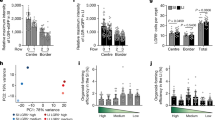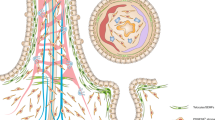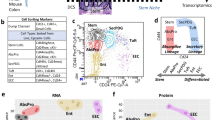Abstract
THE inner surface of the small intestine is covered by a “monolayer” consisting of simple epithelium and a smaller number of goblet cells. The epithelial cells differ in the various parts of the small intestine. Their vertical differentiation was suspected1 and confirmed by Dahlquist and Nordström2. This differentiation arises from the fact that in the crypts of Lieberkühn the cells can undergo mitosis, but are incapable of digesting and absorbing nutrients. According to Grobstein's terminology3, this state corresponds to covert differentiation. Towards the apex of the intestinal villi, the cells gradually develop the enzyme pattern necessary for digestion and absorption, but lose their ability to undergo mitosis. This state would, according to Grobstein, correspond to overt differentiation.
This is a preview of subscription content, access via your institution
Access options
Subscribe to this journal
Receive 51 print issues and online access
$199.00 per year
only $3.90 per issue
Buy this article
- Purchase on Springer Link
- Instant access to full article PDF
Prices may be subject to local taxes which are calculated during checkout
Similar content being viewed by others
References
Fell, B. F., Epithelial Form and Function in the Intestine, 141 (Boyd, London, 1963).
Dahlquist, V., and Nordström, C., Biochim. Biophys. Acta, 113, 624 (1966).
Grobstein, C., Science, 143, 643 (1964).
Wilson, T. H., Intestinal Absorption, 76, 136, 160 (Saunders, Philadelphia and London, 1962).
Hsu, L., and Tappel, A. L., Biochim. Biophys. Acta, 101, 83 (1965).
Ugolev, A. M., Physiol. Rev., 45, 555 (1965).
Padykula, H. A., Fed. Proc., 21, 873 (1962).
Wasserman, R. H., Nature, 201, 997 (1964).
Glasser, J. E., Weiner, I. M., and Lack, L., Amer. J. Physiol., 208, 359 (1965).
Baker, R. D., and Searle, G. W., Proc. Soc. Exp. Biol. and Med., 105, 521 (1960).
Strauss, E. W., and Wilson, T. H., Amer. J. Physiol., 198, 103 (1960).
Clark, S. L., jun., J. Biophys. Biochem. Cytol., 5, 41 (1959).
Kraehenbuhl, J. P., Gloor, E., and Blanc, B., Z. Zellforsch., 70, 209 (1966).
von Möllendorf, W., Münch. Med. Wschr., 71, 569 (1924).
Author information
Authors and Affiliations
Rights and permissions
About this article
Cite this article
BAINTNER, K., VERESS, B. Longitudinal Differentiation of the Small Intestine. Nature 215, 774–776 (1967). https://doi.org/10.1038/215774a0
Received:
Revised:
Published:
Issue Date:
DOI: https://doi.org/10.1038/215774a0
This article is cited by
-
Analysis of structural and biochemical events occurring in the small intestine after dietary polyamine ingestion in suckling rats
Digestive Diseases and Sciences (1996)
-
Reversibility of spermine-induced intestinal maturation in the rat
Digestive Diseases and Sciences (1990)
-
Transmissible gastroenteritis of swine: Virus-intestinal cell interactions I. Immunofluorescence, histopathology and virus production in the small intestine through the course of infection
Archiv f�r die gesamte Virusforschung (1970)
Comments
By submitting a comment you agree to abide by our Terms and Community Guidelines. If you find something abusive or that does not comply with our terms or guidelines please flag it as inappropriate.



